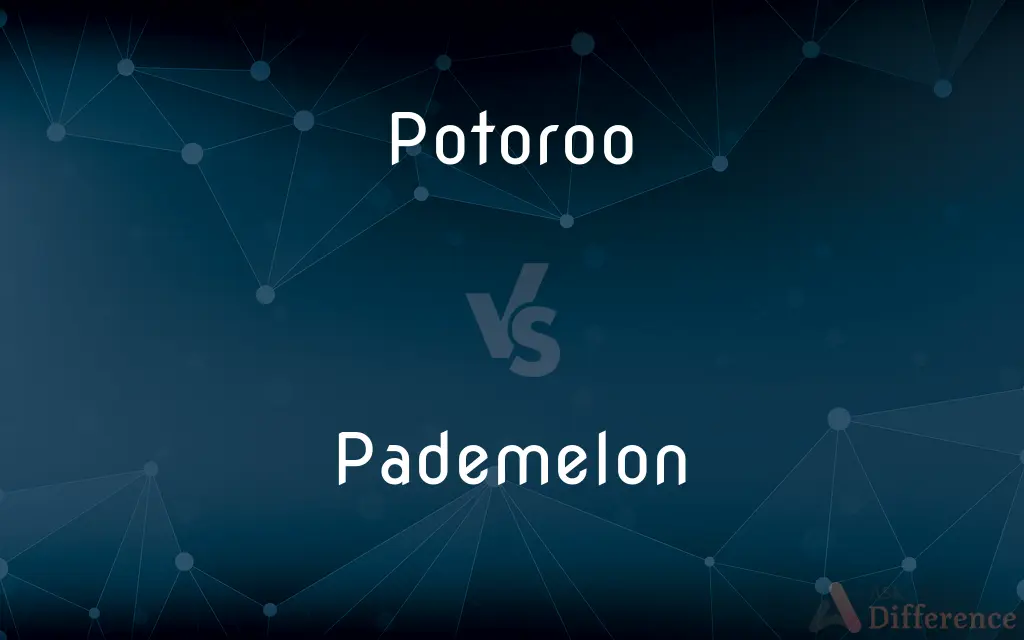Potoroo vs. Pademelon — What's the Difference?
By Urooj Arif & Fiza Rafique — Updated on March 30, 2024
Potoroos are small marsupials resembling miniature kangaroos, part of the rat-kangaroo family, thriving in Australia's underbrush. Pademelons are also small, forest-dwelling marsupials, resembling small wallabies, found in Australia and New Guinea.

Difference Between Potoroo and Pademelon
Table of Contents
ADVERTISEMENT
Key Differences
Potoroos, with their elongated faces and compact, rounded bodies, are among the smaller members of the kangaroo family. They primarily inhabit dense underbrush and forests in Australia, foraging for fungi, roots, and berries. Their size and behavior make them more elusive, contributing to their status as some of the most endangered marsupials. On the other hand, pademelons are slightly larger, with shorter, thicker tails and a more robust build, adapting them well to life in both forest understories and the thick bushland of Australia and New Guinea. They feed on a variety of green vegetation, fallen fruits, and occasionally small invertebrates.
While potoroos focus on a diet heavily reliant on fungi, playing a crucial role in forest ecosystems through spore dispersal, pademelons have a broader diet that allows them to adapt to a variety of forested environments. This dietary flexibility makes pademelons less vulnerable to habitat changes than potoroos.
Potoroos are more solitary, with a secretive nature that makes them difficult to spot in the wild. They have a limited range, often confined to specific areas within Australia, contributing to their vulnerability and endangered status. Conversely, pademelons are more commonly observed due to their wider distribution across Australia and New Guinea, with some species adapting well to human-altered environments.
Conservation efforts for potoroos are critical, focusing on habitat protection and predator control, given their susceptibility to introduced predators like foxes and cats. Pademelons, while also facing threats from habitat loss and predation, benefit from a wider range and greater numbers, making their conservation status generally less critical than that of potoroos.
Both potoroos and pademelons are nocturnal, spending the day in dense vegetation or burrows to avoid predators. Their nocturnal habits, coupled with their ability to move quickly through thick underbrush, are key survival strategies in their respective ecosystems.
ADVERTISEMENT
Comparison Chart
Size
Small, compact
Slightly larger, more robust
Habitat
Dense underbrush and forests in Australia
Forest understories, bushland in Australia and New Guinea
Diet
Primarily fungi, roots, berries
Green vegetation, fallen fruits, small invertebrates
Behavior
Solitary, elusive
More commonly observed, adaptable to human-altered environments
Conservation Status
Endangered, vulnerable due to limited range
Generally less critical, benefits from wider range
Role in Ecosystem
Spore dispersal, aiding forest ecosystems
Flexible diet allows adaptation to various environments
Nocturnal Habits
Yes, avoids predators by day
Yes, primarily active at night
Compare with Definitions
Potoroo
Endangered, with conservation efforts focusing on habitat protection.
Protecting potoroo habitats is crucial for their survival.
Pademelon
Has a varied diet of green vegetation and fruits.
Pademelons contribute to the dispersal of seeds through their diet.
Potoroo
A small marsupial with an elongated face, part of the kangaroo family, endangered and native to Australia.
The Long-footed Potoroo plays a key role in its ecosystem through fungal spore dispersal.
Pademelon
Nocturnal, with habits that help avoid predation.
Pademelons forage for food at night, using the cover of darkness for safety.
Potoroo
Primarily feeds on fungi, contributing to forest health.
Potoroos' diet of truffles aids in the spread of mycorrhizal fungi.
Pademelon
A small forest-dwelling marsupial, resembling a compact wallaby, found in Australia and New Guinea.
The Tasmanian Pademelon thrives in dense underbrush and forest edges.
Potoroo
Nocturnal, using dense underbrush for shelter during the day.
Potoroos are most active at night when foraging for food.
Pademelon
Adapts well to a variety of environments, including human-altered landscapes.
Pademelons are often seen near forested areas close to human habitation.
Potoroo
Known for its solitary and elusive nature, making it a rare sight.
Spotting a potoroo in the wild is a sign of a healthy forest ecosystem.
Pademelon
Faces threats from habitat loss and predation but has a wider range.
Conservation efforts for pademelons include predator control and habitat conservation.
Potoroo
Potoroo is a common name for species of Potorous, a genus of smaller marsupials. They are allied to the Macropodiformes, the suborder of kangaroo, wallaby, and other rat-kangaroo genera.
Pademelon
Pademelons are small marsupials of the genus Thylogale found in Australia and New Guinea. They are some of the smallest members of the family Macropodidae.
Potoroo
Any of several rat kangaroos of the genus Potorous of Australia, feeding primarily on plants and fungi.
Pademelon
Any of several small macropods of the genus Thylogale of New Guinea, Australia, and adjacent islands, having short thick tails and sometimes considered to be small wallabies.
Potoroo
Any species of the genus Potorous of the rat kangaroo family Potoroidae, endemic to Australia.
Pademelon
Any species of the genus Thylogale of small macropods.
Potoroo
Any small kangaroo belonging to Hypsiprymnus, Bettongia, and allied genera, native of Australia and Tasmania. Called also kangaroo rat.
Pademelon
Alternative form of paddymelon
Potoroo
Australian rat kangaroos
Pademelon
Any of several small reddish-brown wallabies of scrubby areas of Australia and New Guinea, especially those belonging to the genus Thylogale; a paddymelon. See Wallaby
Pademelon
Small reddish-brown wallabies of scrubby areas of Australia and New Guinea
Common Curiosities
Can pademelons be found outside of Australia?
Yes, pademelons are also native to New Guinea, showcasing their adaptability to various forested environments beyond Australia.
How do the diets of potoroos and pademelons differ?
Potoroos primarily feed on fungi, while pademelons have a broader diet that includes green vegetation, fruits, and occasionally small invertebrates.
What role does the nocturnal behavior of these marsupials play in their survival?
Their nocturnal behavior minimizes the risk of predation and allows them to forage for food with reduced competition and cooler temperatures.
Why are pademelons important to their ecosystems?
Pademelons play a crucial role in their ecosystems by dispersing seeds and aiding in the growth of forest vegetation through their dietary habits.
What conservation measures are in place for potoroos?
Conservation measures for potoroos include habitat protection, controlling introduced predators, and breeding programs to boost their population.
How are potoroos and pademelons adapted to avoid predators?
Both are nocturnal and use dense vegetation for shelter during the day, with quick movements to escape predators when necessary.
What distinguishes potoroos from other marsupials?
Potoroos are distinguished by their small size, elongated faces, and a diet primarily consisting of fungi, making them unique within the marsupial family.
Are there different species of pademelons?
Yes, there are several species of pademelons, each adapted to specific environments in Australia and New Guinea, with varying sizes and habits.
How can individuals contribute to the conservation of potoroos and pademelons?
Individuals can contribute by supporting habitat conservation efforts, participating in awareness programs, and advocating for policies that protect these species and their environments.
What makes potoroos vulnerable to extinction?
Potoroos are vulnerable due to their limited habitat range, susceptibility to predators like foxes and cats, and habitat destruction.
Share Your Discovery

Previous Comparison
Offering vs. Sacrifice
Next Comparison
Concept vs. ApproachAuthor Spotlight
Written by
Urooj ArifUrooj is a skilled content writer at Ask Difference, known for her exceptional ability to simplify complex topics into engaging and informative content. With a passion for research and a flair for clear, concise writing, she consistently delivers articles that resonate with our diverse audience.
Co-written by
Fiza RafiqueFiza Rafique is a skilled content writer at AskDifference.com, where she meticulously refines and enhances written pieces. Drawing from her vast editorial expertise, Fiza ensures clarity, accuracy, and precision in every article. Passionate about language, she continually seeks to elevate the quality of content for readers worldwide.
















































